
April 18, 2023 2023 First Quarter Earnings Presentation

1 Forward–Looking Statements Certain statements contained in this Presentation that are not historical in nature may be considered forward-looking statements within the meaning of the Private Securities Litigation Reform Act of 1995. These forward-looking statements include, without limitation, statements regarding the Company’s future plans, results, strategies, and expectations, including expectations around changing economic markets. These statements can generally be identified by the use of the words and phrases “may,” “will,” “should,” “could,” “would,” “goal,” “plan,” “potential,” “estimate,” “project,” “believe,” “intend,” “anticipate,” “expect,” “target,” “aim,” “predict,” “continue,” “seek,” “project,” and other variations of such words and phrases and similar expressions. These forward-looking statements are not historical facts, and are based upon management's current expectations, estimates, and projections, many of which, by their nature, are inherently uncertain and beyond the Company’s control. The inclusion of these forward-looking statements should not be regarded as a representation by the Company or any other person that such expectations, estimates, and projections will be achieved. Accordingly, the Company cautions shareholders and investors that any such forward-looking statements are not guarantees of future performance and are subject to risks, assumptions, and uncertainties that are difficult to predict. Actual results may prove to be materially different from the results expressed or implied by the forward-looking statements. A number of factors could cause actual results to differ materially from those contemplated by the forward-looking statements including, without limitation, (1) current and future economic conditions, including the effects of inflation, interest rate fluctuations, changes in the economy or global supply chain, supply-demand imbalances affecting local real estate prices, and high unemployment rates in the local or regional economies in which the Company operates and/or the US economy generally, (2) changes in government interest rate policies and its impact on the Company’s business, net interest margin, and mortgage operations, (3) any continuation of the recent turmoil in the banking industry, including the associated impact to the Company and other financial institutions of any regulatory changes or other mitigation efforts taken by government agencies in response, (4) increased competition for deposits, (5) the Company’s ability to effectively manage problem credits, (6) any deterioration in commercial real estate market fundamentals, (7) the Company’s ability to identify potential candidates for, consummate, and achieve synergies from, potential future acquisitions, (8) the Company’s ability to successfully execute its various business strategies, (9) changes in state and federal legislation, regulations or policies applicable to banks and other financial service providers, including legislative developments, (10) the potential impact of the phase-out of the London Interbank Offered Rate ("LIBOR") or other changes involving LIBOR, (11) the effectiveness of the Company’s cybersecurity controls and procedures to prevent and mitigate attempted intrusions, (12) the Company's dependence on information technology systems of third party service providers and the risk of systems failures, interruptions, or breaches of security, and (13) the impact of natural disasters, pandemics, and/or acts of war or terrorism, (14) international or political instability, including the impacts related to or resulting from Russia’s military action in Ukraine and additional sanctions and export controls, as well as the broader impacts to financial markets and the global macroeconomic and geopolitical environments, and (15) general competitive, economic, political, and market conditions. Further information regarding the Company and factors which could affect the forward-looking statements contained herein can be found in the Company’s Annual Report on Form 10-K for the fiscal year ended December 31, 2022, and in any of the Company’s subsequent filings with the SEC. Many of these factors are beyond the Company’s ability to control or predict. If one or more events related to these or other risks or uncertainties materialize, or if the underlying assumptions prove to be incorrect, actual results may differ materially from the forward-looking statements. Accordingly, shareholders and investors should not place undue reliance on any such forward-looking statements. Any forward-looking statement speaks only as of the date of this presentation, and the Company undertakes no obligation to publicly update or review any forward-looking statement, whether as a result of new information, future developments or otherwise, except as required by law. New risks and uncertainties may emerge from time to time, and it is not possible for the Company to predict their occurrence or how they will affect the Company. The Company qualifies all forward-looking statements by these cautionary statements.
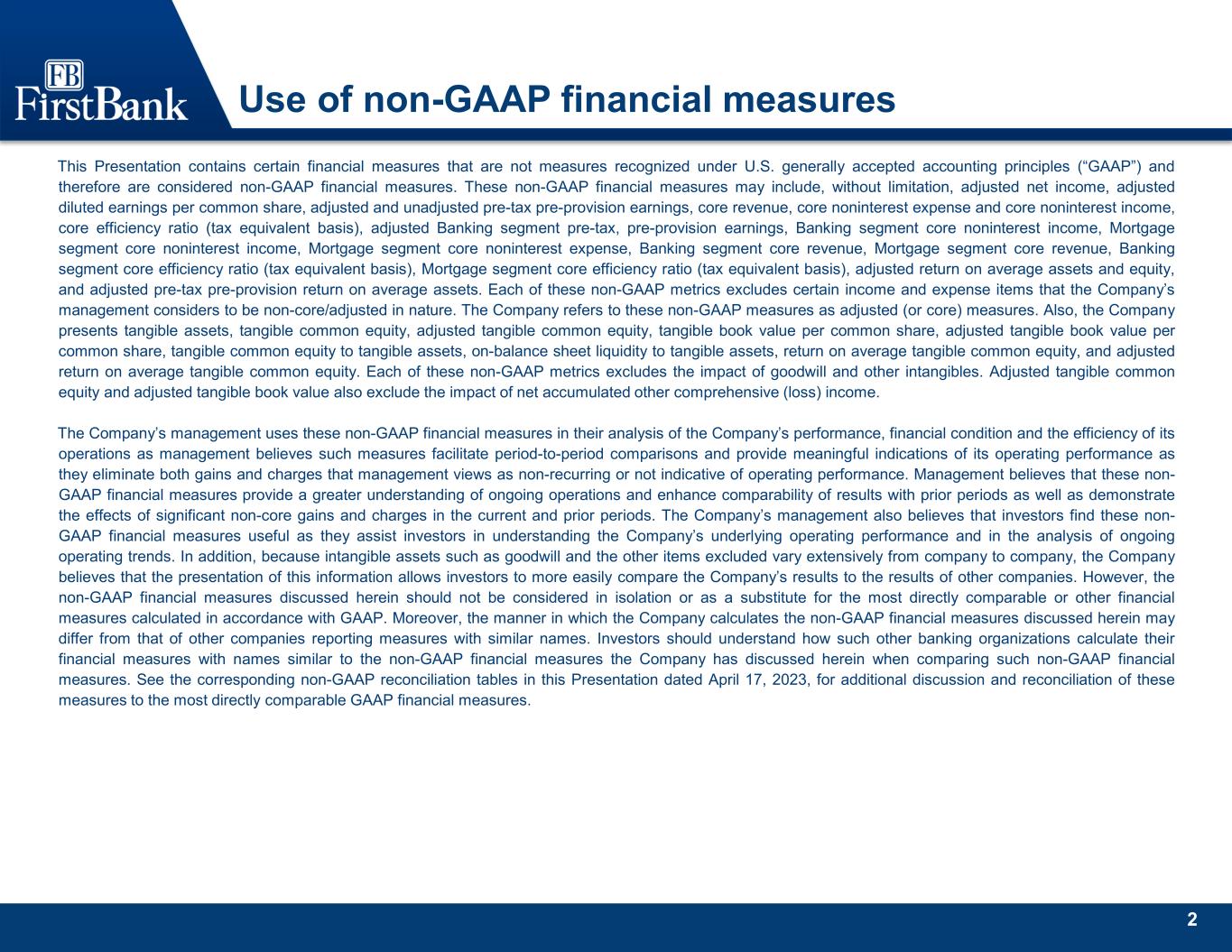
2 Use of non-GAAP financial measures This Presentation contains certain financial measures that are not measures recognized under U.S. generally accepted accounting principles (“GAAP”) and therefore are considered non-GAAP financial measures. These non-GAAP financial measures may include, without limitation, adjusted net income, adjusted diluted earnings per common share, adjusted and unadjusted pre-tax pre-provision earnings, core revenue, core noninterest expense and core noninterest income, core efficiency ratio (tax equivalent basis), adjusted Banking segment pre-tax, pre-provision earnings, Banking segment core noninterest income, Mortgage segment core noninterest income, Mortgage segment core noninterest expense, Banking segment core revenue, Mortgage segment core revenue, Banking segment core efficiency ratio (tax equivalent basis), Mortgage segment core efficiency ratio (tax equivalent basis), adjusted return on average assets and equity, and adjusted pre-tax pre-provision return on average assets. Each of these non-GAAP metrics excludes certain income and expense items that the Company’s management considers to be non-core/adjusted in nature. The Company refers to these non-GAAP measures as adjusted (or core) measures. Also, the Company presents tangible assets, tangible common equity, adjusted tangible common equity, tangible book value per common share, adjusted tangible book value per common share, tangible common equity to tangible assets, on-balance sheet liquidity to tangible assets, return on average tangible common equity, and adjusted return on average tangible common equity. Each of these non-GAAP metrics excludes the impact of goodwill and other intangibles. Adjusted tangible common equity and adjusted tangible book value also exclude the impact of net accumulated other comprehensive (loss) income. The Company’s management uses these non-GAAP financial measures in their analysis of the Company’s performance, financial condition and the efficiency of its operations as management believes such measures facilitate period-to-period comparisons and provide meaningful indications of its operating performance as they eliminate both gains and charges that management views as non-recurring or not indicative of operating performance. Management believes that these non- GAAP financial measures provide a greater understanding of ongoing operations and enhance comparability of results with prior periods as well as demonstrate the effects of significant non-core gains and charges in the current and prior periods. The Company’s management also believes that investors find these non- GAAP financial measures useful as they assist investors in understanding the Company’s underlying operating performance and in the analysis of ongoing operating trends. In addition, because intangible assets such as goodwill and the other items excluded vary extensively from company to company, the Company believes that the presentation of this information allows investors to more easily compare the Company’s results to the results of other companies. However, the non-GAAP financial measures discussed herein should not be considered in isolation or as a substitute for the most directly comparable or other financial measures calculated in accordance with GAAP. Moreover, the manner in which the Company calculates the non-GAAP financial measures discussed herein may differ from that of other companies reporting measures with similar names. Investors should understand how such other banking organizations calculate their financial measures with names similar to the non-GAAP financial measures the Company has discussed herein when comparing such non-GAAP financial measures. See the corresponding non-GAAP reconciliation tables in this Presentation dated April 17, 2023, for additional discussion and reconciliation of these measures to the most directly comparable GAAP financial measures.

3 1Q 2023 Highlights Key highlights Strong capital ratios1 with no securities categorized HTM: – CET1 11.3% – Tier 1 RBC 11.6% – Total RBC 13.5% – Leverage ratio 10.3% Total deposits grew 12.2% annualized in 1Q 2023, or $327.1 million. Public funds accounted for the growth with a $313.2 million increase Paid down borrowings 25% in 1Q 2023; strong liquidity profile including on balance sheet liquidity to assets of 12.3% and $6.8B in available additional sources of liquidity Loans HFI grew 3.0% annualized in 1Q 2023, or $67.8 million, as part of balance sheet management strategy Strong ACL/loans HFI of 1.48% and recorded provisions for credit losses of $0.5 million including provision expense related to loans held for investment of $5.0 million and a reversal of provision of $4.5 million related to unfunded loan commitments Nonperforming assets as a percentage of total assets at the end of the 1Q 2023 were 0.61% compared to 0.68% as of 4Q 2022 Commercial loans HFS portfolio assumed with 2020 Franklin combination has been reduced to $9.5 million consisting of 2 relationships Financial results 1 Total regulatory capital, FB Financial Corporation is preliminary and subject to change. 2 Results are non-GAAP. See “Use of non-GAAP financial measures” and the Appendix hereto for a discussion and reconciliation of non-GAAP financial measures to the most directly comparable GAAP financial measures. 1Q 2023 Diluted earnings per share Adjusted diluted earnings per share2 $0.78 $0.76 Net income ($mm) Adjusted net income2 ($mm) $36.4 $35.7 Return on average assets Adjusted return on average assets2 1.15% 1.13% Return on average common equity Adjusted return on average common equity2 11.0% 10.8% Return on average tangible common equity2 Adjusted return on average tangible common equity1 13.6% 13.3% Adjusted pre-tax, pre-provision earnings2 ($mm) $45.7 Net interest margin Positive impact of accretion and nonaccrual interest (bps) 3.51% 2 Total common equity / total assets Tangible common equity / tangible assets2 10.5% 8.68%

4 21% 31% 22% 8% 3% 1Q22 2Q22 3Q22 4Q22 1Q23 Driving shareholder value ¹ See “Use of non-GAAP financial measures” and the Appendix hereto for a discussion and reconciliation of non-GAAP measures to the most directly comparable GAAP financial measures. Adjusted Earnings per Share1 $2.83 $3.73 $3.78 $2.91 $0.76 2019 2020 2021 2022 YTD 2023 Short Term Performance Dashboard Loans HFI to deposit ratio Total Deposits ($bn) Annualized Loans (HFI) Growth Tangible Book Value per Share1 $18.55 $21.73 $24.67 $22.90 $23.86 $18.16 $21.15 $24.55 $26.53 $27.06 2019 2020 2021 2022 1Q23 TBVPS Adj. TBVPS (Ex. AOCI) Adjusted ROATCE1 12% 11% 12% 15% 13% 1Q22 2Q22 3Q22 4Q22 1Q23 $11.0 $10.5 $10.0 $10.9 $11.2 1Q22 2Q22 3Q22 4Q22 1Q23 73% 82% 91% 86% 84% 1Q22 2Q22 3Q22 4Q22 1Q23
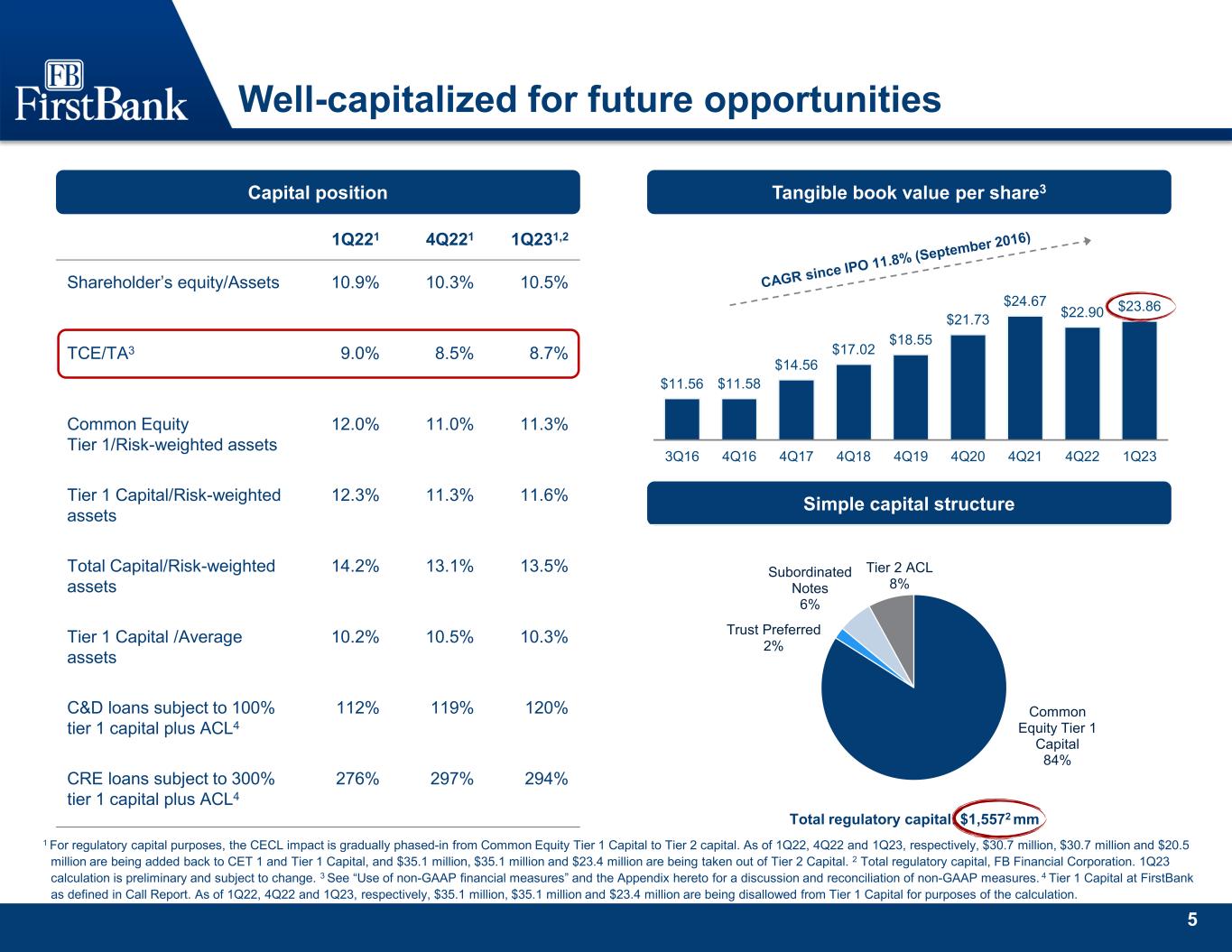
5 Well-capitalized for future opportunities Tangible book value per share3 Simple capital structure Common Equity Tier 1 Capital 84% Trust Preferred 2% Subordinated Notes 6% Tier 2 ACL 8% Total regulatory capital: $1,5572 mm $11.56 $11.58 $14.56 $17.02 $18.55 $21.73 $24.67 $22.90 $23.86 3Q16 4Q16 4Q17 4Q18 4Q19 4Q20 4Q21 4Q22 1Q23 1Q221 4Q221 1Q231,2 Shareholder’s equity/Assets 10.9% 10.3% 10.5% TCE/TA3 9.0% 8.5% 8.7% Common Equity Tier 1/Risk-weighted assets 12.0% 11.0% 11.3% Tier 1 Capital/Risk-weighted assets 12.3% 11.3% 11.6% Total Capital/Risk-weighted assets 14.2% 13.1% 13.5% Tier 1 Capital /Average assets 10.2% 10.5% 10.3% C&D loans subject to 100% tier 1 capital plus ACL4 112% 119% 120% CRE loans subject to 300% tier 1 capital plus ACL4 276% 297% 294% Capital position 1 For regulatory capital purposes, the CECL impact is gradually phased-in from Common Equity Tier 1 Capital to Tier 2 capital. As of 1Q22, 4Q22 and 1Q23, respectively, $30.7 million, $30.7 million and $20.5 million are being added back to CET 1 and Tier 1 Capital, and $35.1 million, $35.1 million and $23.4 million are being taken out of Tier 2 Capital. 2 Total regulatory capital, FB Financial Corporation. 1Q23 calculation is preliminary and subject to change. 3 See “Use of non-GAAP financial measures” and the Appendix hereto for a discussion and reconciliation of non-GAAP measures. 4 Tier 1 Capital at FirstBank as defined in Call Report. As of 1Q22, 4Q22 and 1Q23, respectively, $35.1 million, $35.1 million and $23.4 million are being disallowed from Tier 1 Capital for purposes of the calculation.

6 Noninterest- bearing checking 22% Interest-bearing checking 30% Money market 31% Savings 4% Time 13% 52% Checking accounts Valuable core deposit base ¹ Noninterest bearing deposits includes mortgage servicing-related deposits of $131.1 million, $133.2 million, $140.8 million, $75.6 million, and $92.9 million for the quarters ended March 31, 2022, June 30, 2022, September 30, 2022, December 31, 2022, and March 31, 2023 respectively. Total deposits1 ($millions) Cost of deposits Deposit composition $2,788 $2,896 $2,997 $2,677 $2,489 $8,208 $7,647 $7,009 $8,179 $8,694 $10,996 $10,543 $10,006 $10,856 $11,183 1Q22 2Q22 3Q22 4Q22 1Q23 Noninterest-bearing Deposits Interest-bearing Deposits 25.4% 27.5% 29.6% 24.7% 22.3% 0.20% 0.25% 0.52% 1.20% 1.94% 0.0% 5.0% 10.0% 15.0% 20.0% 25.0% 30.0% 35.0% 1Q22 2Q22 3Q22 4Q22 1Q23 Noninterest-bearing (%) Cost of total deposits (%)

7 $4,659 $4,628 $4,621 $4,986 $5,028 $3,700 $3,568 $3,759 $3,797 $3,768 $2,637 $2,347 $1,626 $2,073 $2,387 $10,996 $10,543 $10,006 $10,856 $11,183 1Q22 2Q22 3Q22 4Q22 1Q23 Consumer Commercial Public $7,631 $7,320 $6,653 $7,289 $7,927 $3,365 $3,223 $3,353 $3,567 $3,256 $10,996 $10,543 $10,006 $10,856 $11,183 1Q22 2Q22 3Q22 4Q22 1Q23 Uninsured and uncollateralized deposits Insured and collateralized deposits Well-balanced deposit portfolio Deposits by customer segment ($mm) Customer Deposit funded balance sheet 1Q23 insured and collateralized by segment1 ($mm)Estimated insured or collateralized deposits1 ($mm) ¹ Balances are estimated for all periods shown. $3,842 $1,698 $66 $1,186 $2,070 $5,028 $3,768 $2,387 Consumer Commercial Public Insured Collateralized Uninsured, uncollateralized 29% 71% ~254 thousand accounts with average balance of ~$43 thousand 97.4% 97.0% 91.2% 94.2% 95.3% 1.4% 1.5% 6.6% 3.6% 2.7% 1Q22 2Q22 3Q22 4Q22 1Q23 Deposits / Liabilities Borrowings / Liabilities 21% 34% 45%
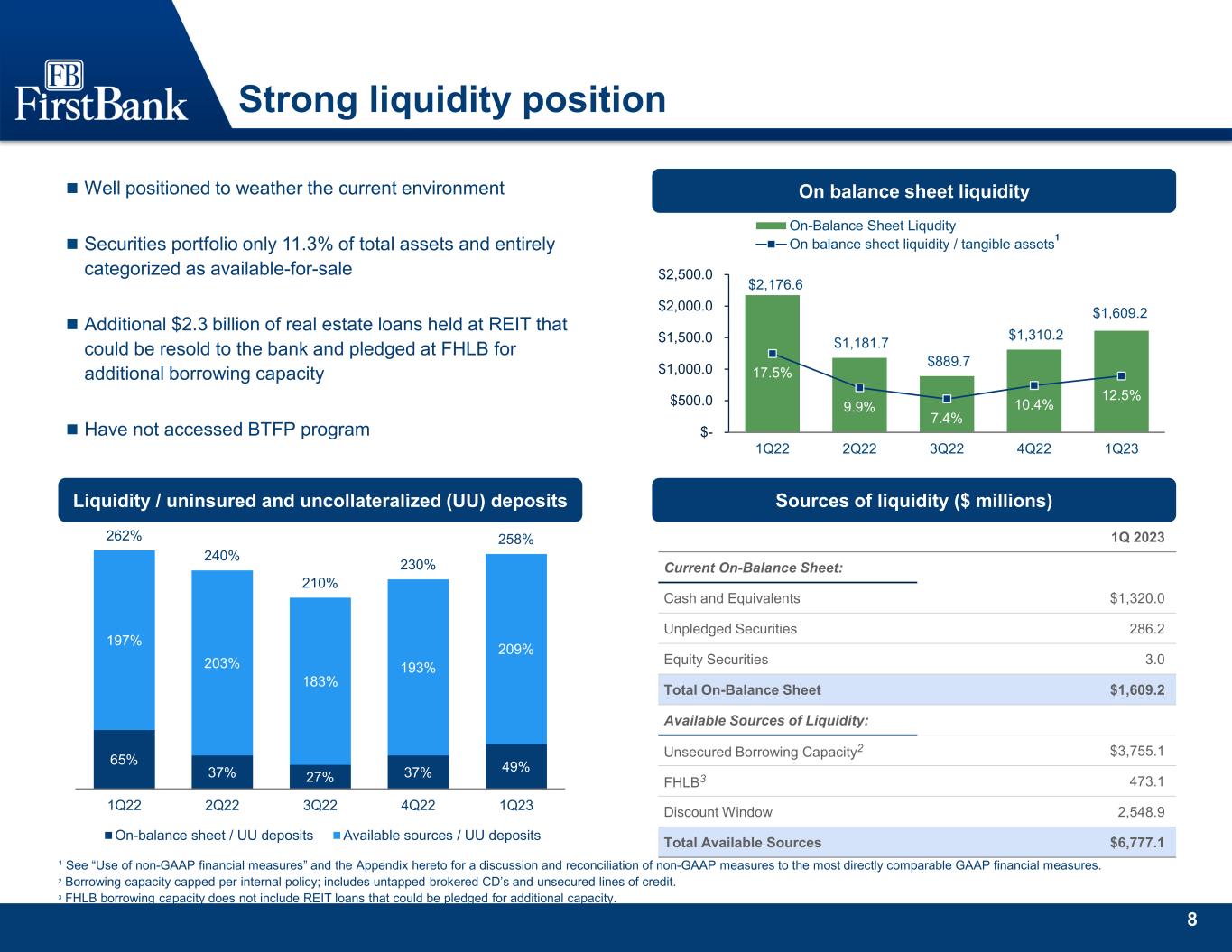
8 $2,176.6 $1,181.7 $889.7 $1,310.2 $1,609.2 17.5% 9.9% 7.4% 10.4% 12.5% $- $500.0 $1,000.0 $1,500.0 $2,000.0 $2,500.0 1Q22 2Q22 3Q22 4Q22 1Q23 On-Balance Sheet Liqudity On balance sheet liquidity / tangible assets Strong liquidity position On balance sheet liquidity Liquidity / uninsured and uncollateralized (UU) deposits Sources of liquidity ($ millions) 1Q 2023 Current On-Balance Sheet: Cash and Equivalents $1,320.0 Unpledged Securities 286.2 Equity Securities 3.0 Total On-Balance Sheet $1,609.2 Available Sources of Liquidity: Unsecured Borrowing Capacity2 $3,755.1 FHLB3 473.1 Discount Window 2,548.9 Total Available Sources $6,777.1 Well positioned to weather the current environment Securities portfolio only 11.3% of total assets and entirely categorized as available-for-sale Additional $2.3 billion of real estate loans held at REIT that could be resold to the bank and pledged at FHLB for additional borrowing capacity Have not accessed BTFP program ¹ See “Use of non-GAAP financial measures” and the Appendix hereto for a discussion and reconciliation of non-GAAP measures to the most directly comparable GAAP financial measures. 2 Borrowing capacity capped per internal policy; includes untapped brokered CD’s and unsecured lines of credit. 3 FHLB borrowing capacity does not include REIT loans that could be pledged for additional capacity. 65% 37% 27% 37% 49% 197% 203% 183% 193% 209% 262% 240% 210% 230% 258% 1Q22 2Q22 3Q22 4Q22 1Q23 On-balance sheet / UU deposits Available sources / UU deposits

9 Office 19% Retail 24% Hotel 16% Warehouse / Industrial 17% Land-Manufactured Home Communities 6% Self Storage 5% Healthcare Facility 2% Other 11% 1-4 Family to be sold 46% Commercial Land 22% 1-4 Consumer Construction 8% Multifamily 9% Retail 4% Warehouse 2% Office 1% Other 8% 1-4 family 17% 1-4 family HELOC 5% Multifamily 5% C&D 18% CRE 21% C&I 30% Other 4% Balanced loan portfolio CRE2 exposure by type Portfolio mix Note: Data as of March 31, 2023 1 C&I includes owner-occupied CRE. 2 Excludes owner-occupied CRE. C&I1 exposure by industry ($ millions) 1 2 C&D exposure by type
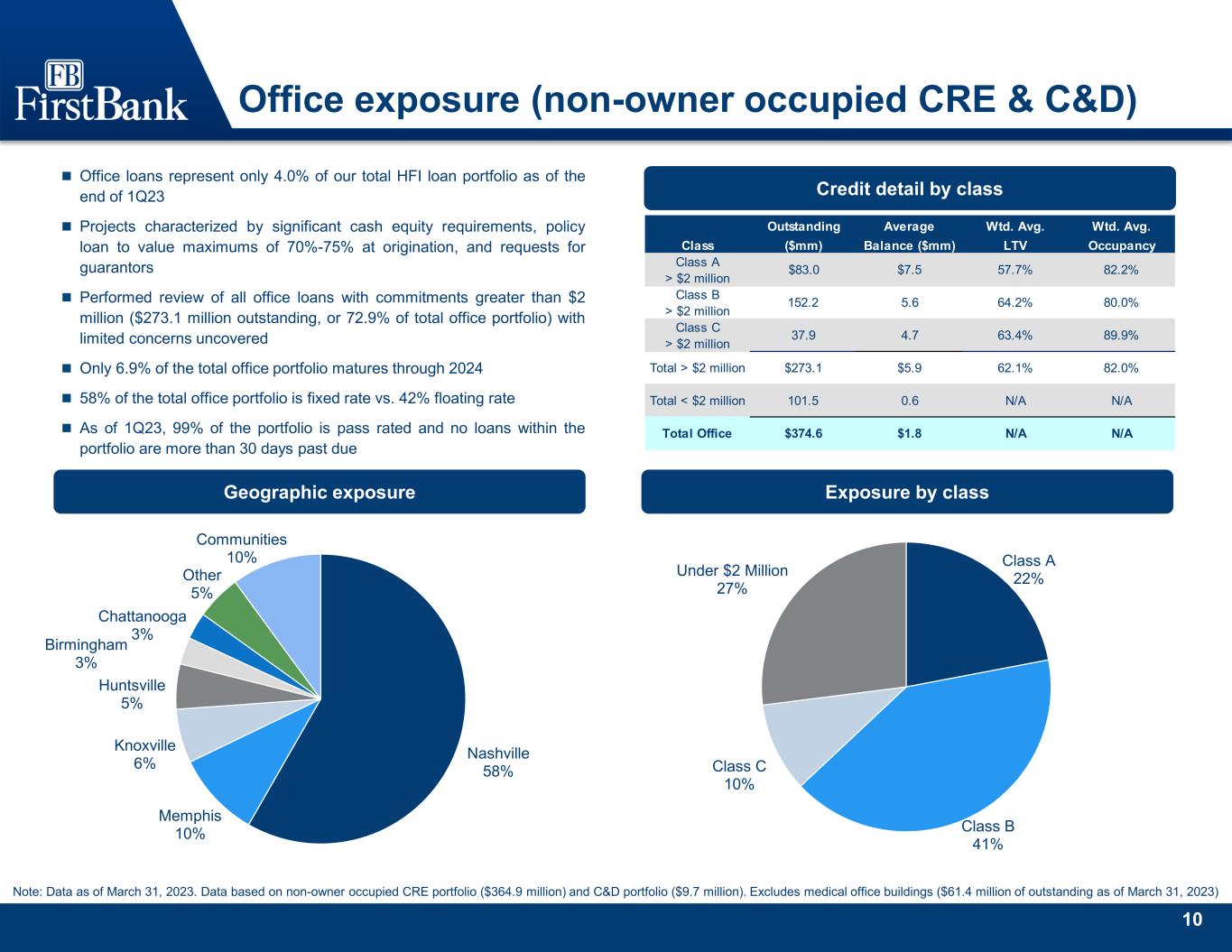
10 Nashville 58% Memphis 10% Knoxville 6% Huntsville 5% Birmingham 3% Chattanooga 3% Other 5% Communities 10% Office exposure (non-owner occupied CRE & C&D) Office loans represent only 4.0% of our total HFI loan portfolio as of the end of 1Q23 Projects characterized by significant cash equity requirements, policy loan to value maximums of 70%-75% at origination, and requests for guarantors Performed review of all office loans with commitments greater than $2 million ($273.1 million outstanding, or 72.9% of total office portfolio) with limited concerns uncovered Only 6.9% of the total office portfolio matures through 2024 58% of the total office portfolio is fixed rate vs. 42% floating rate As of 1Q23, 99% of the portfolio is pass rated and no loans within the portfolio are more than 30 days past due Class A 22% Class B 41% Class C 10% Under $2 Million 27% Geographic exposure Note: Data as of March 31, 2023. Data based on non-owner occupied CRE portfolio ($364.9 million) and C&D portfolio ($9.7 million). Excludes medical office buildings ($61.4 million of outstanding as of March 31, 2023) Exposure by class Credit detail by class Outstanding Average Wtd. Avg. Wtd. Avg. Class ($mm) Balance ($mm) LTV Occupancy Class A > $2 million $83.0 $7.5 57.7% 82.2% Class B > $2 million 152.2 5.6 64.2% 80.0% Class C > $2 million 37.9 4.7 63.4% 89.9% Total > $2 million $273.1 $5.9 62.1% 82.0% Total < $2 million 101.5 0.6 N/A N/A Total Office $374.6 $1.8 N/A N/A

11 0.40% 0.45% 0.40% 0.41% 0.38% 0.22% 0.20% 0.16% 0.04% 0.01% 0.07% 0.07% 0.44% 0.46% 0.62% 0.68% 0.61% 1Q22 2Q22 3Q22 4Q22 1Q23 Commercial loans HFS Optional GNMA repurchase Other NPAs 1.50% 1.46% 1.48% 1.44% 1.48% 1Q22 2Q22 3Q22 4Q22 1Q23 (0.03%) 0.09% 0.00% 0.02% 0.02% 1Q22 2Q22 3Q22 4Q22 1Q23 Asset quality remains solid Nonperforming Assets / Assets Nonperforming Loans (HFI) / Loans (HFI) LLR/loans HFI Net charge-offs (recoveries) / average loans 1 Includes other real estate owned and repossessed assets–see page 12 of the Quarterly Financial Supplement. 0.51% 0.51% 0.47% 0.49% 0.49% 1Q22 2Q22 3Q22 4Q22 1Q23 1
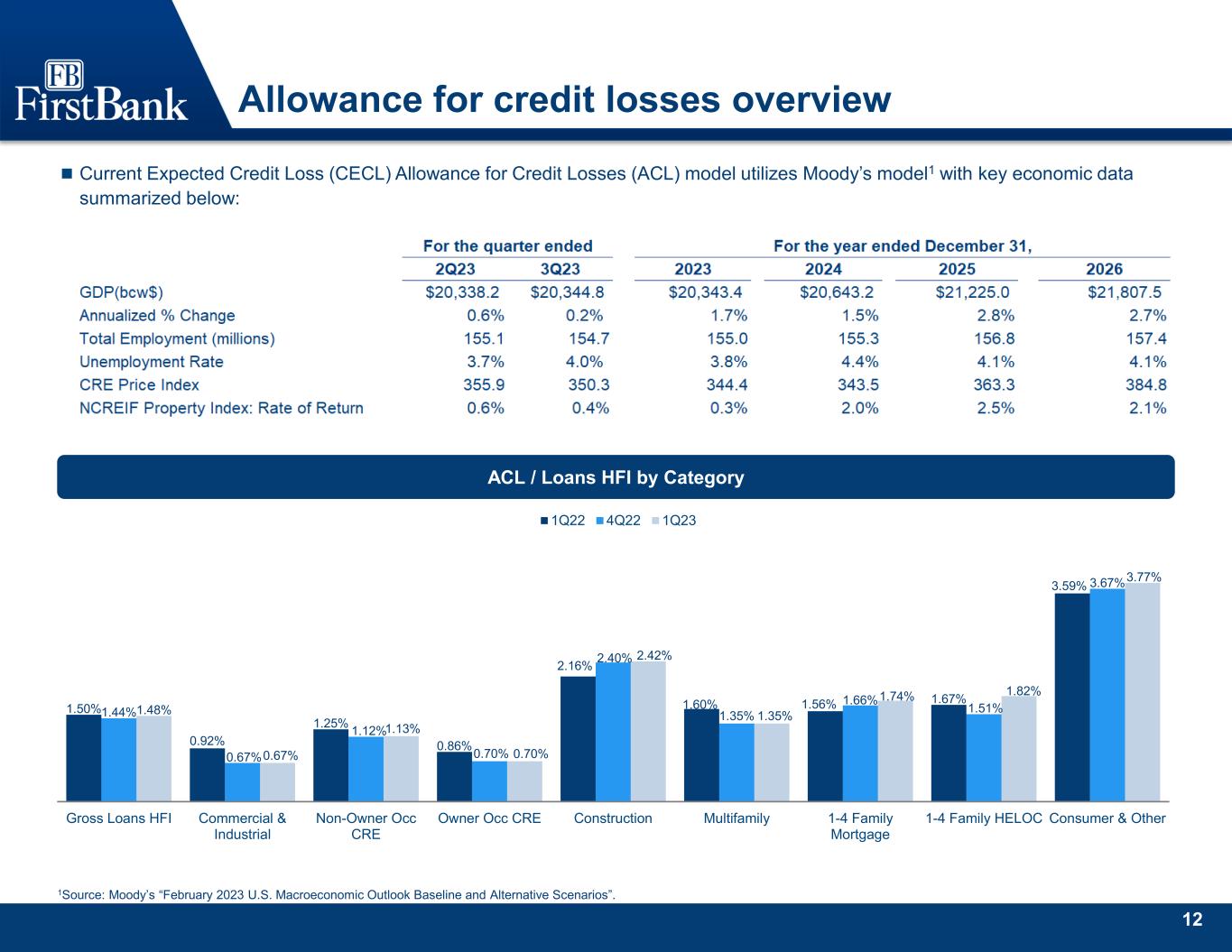
12 1.50% 0.92% 1.25% 0.86% 2.16% 1.60% 1.56% 1.67% 3.59% 1.44% 0.67% 1.12% 0.70% 2.40% 1.35% 1.66% 1.51% 3.67% 1.48% 0.67% 1.13% 0.70% 2.42% 1.35% 1.74% 1.82% 3.77% Gross Loans HFI Commercial & Industrial Non-Owner Occ CRE Owner Occ CRE Construction Multifamily 1-4 Family Mortgage 1-4 Family HELOC Consumer & Other 1Q22 4Q22 1Q23 Allowance for credit losses overview ACL / Loans HFI by Category Current Expected Credit Loss (CECL) Allowance for Credit Losses (ACL) model utilizes Moody’s model1 with key economic data summarized below: 1Source: Moody’s “February 2023 U.S. Macroeconomic Outlook Baseline and Alternative Scenarios”.

13 Strong net interest margin Historical yield and costs ¹ Includes tax-equivalent adjustment. 2 Excess liquidity defined as interest-bearing deposits with other financial institutions in excess of 5% of average tangible assets. Assumes funded from all interest bearing liabilities. $5,000 $7,000 $9,000 $11,000 $13,000 -- 1.0% 2.0% 3.0% 4.0% 5.0% 6.0% 7.0% 1Q22 2Q22 3Q22 4Q22 1Q23 Av g. in te re st e ar ni ng as se ts ($ m m ) Yi el ds a nd C os ts (% ) Average interest earning assets Yield on loans Cost of deposits NIM NIM1 3.04% 3.52% 3.93% 3.78% 3.51% Impact of accretion and nonaccrual interest (bps) (7) 2 5 3 2 Impact of excess liquidity2 (bps) (29) (14) 0 0 (1) Deposit Cost: Cost of MMDA 0.21% 0.20% 0.73% 2.03% 2.95% Cost of customer time 0.50% 0.64% 0.87% 1.79% 2.54% Cost of interest-bearing 0.27% 0.33% 0.74% 1.67% 2.53% Total deposit cost 0.20% 0.25% 0.52% 1.20% 1.94% Loans HFI Yield: Contractual interest 4.12% 4.24% 4.79% 5.45% 5.90% Origination and other loan fee income 0.26% 0.33% 0.30% 0.18% 0.13% Nonaccrual interest 0.05% 0.03% 0.02% 0.03% 0.01% (Amortization) accretion on purchased loans (0.12%) 0.00% 0.05% 0.01% 0.01% Syndication fee income 0.00% 0.06% 0.00% 0.00% 0.00% Total loan (HFI) yield 4.31% 4.66% 5.16% 5.67% 6.05%

14 Mortgage performance in 1Q 2023 Highlights Mortgage segment essentially broke even with pre-tax net loss of $0.2 million in 1Q 2023, a seasonally slow quarter for mortgage originations Interest rate lock commitment volume increased 33.2% in 1Q 2023 compared to 4Q 2022 Decay and interest rate volatility led to MSR fair value losses, net of hedging of $3.4 million in 1Q Mortgage markets continue to be under pressure; we expect minimal contribution in Q2 Mortgage banking income ($mm) 1Q22 4Q22 1Q23 Gain on Sale $29.4 $9.0 $8.1 Fair value changes ($7.5) ($2.3) ($0.4) Servicing Revenue $7.4 $7.3 $7.8 Fair value MSR changes $0.2 ($4.9) ($3.4) Total Income $29.5 $9.1 $12.1 2.29% 2.43% 1.95% 3.36% 2.45% 1Q22 2Q22 3Q22 4Q22 1Q23 Interest rate lock commitment volume ($mm) Mortgage segment gain on sale margin . $747 $588 $351 $239 $323 $562 $113 $58 $43 $52 $1,309 $701 $409 $282 $375 1Q22 2Q22 3Q22 4Q22 1Q23 Purchase Refinance

15 Managing expenses Highlights Consolidated 1Q 2023 core efficiency ratio¹ of 63.4% Banking segment noninterest expense grew 2.4% as expected due to annual compensation increases and expense management initiatives; core efficiency ratio impacted by accelerating deposit growth and costs Mortgage core efficiency ratio improving as a result of 2022’s restructuring and improved interest rate lock commitment volumes in 1Q 2023, which led to breakeven performance in the quarter ¹ See “Use of non-GAAP financial measures” and the Appendix hereto for a discussion and reconciliation of non-GAAP measures to the most directly comparable GAAP financial measures. Core efficiency ratio (tax-equivalent basis)¹ 58.7% 51.3% 53.8% 54.7% 59.6% 68.1% 61.1% 60.7% 61.0% 63.4% 100.5% 111.8% 128.9% 145.4% 98.4% 1Q22 2Q22 3Q22 4Q22 1Q23 Banking segment Consolidated Mortgage segment

16 Appendix

17 GAAP reconciliation and use of non-GAAP financial measures Adjusted net income and diluted earnings per share

18 GAAP reconciliation and use of non-GAAP financial measures Adjusted pre-tax, pre-provision earnings
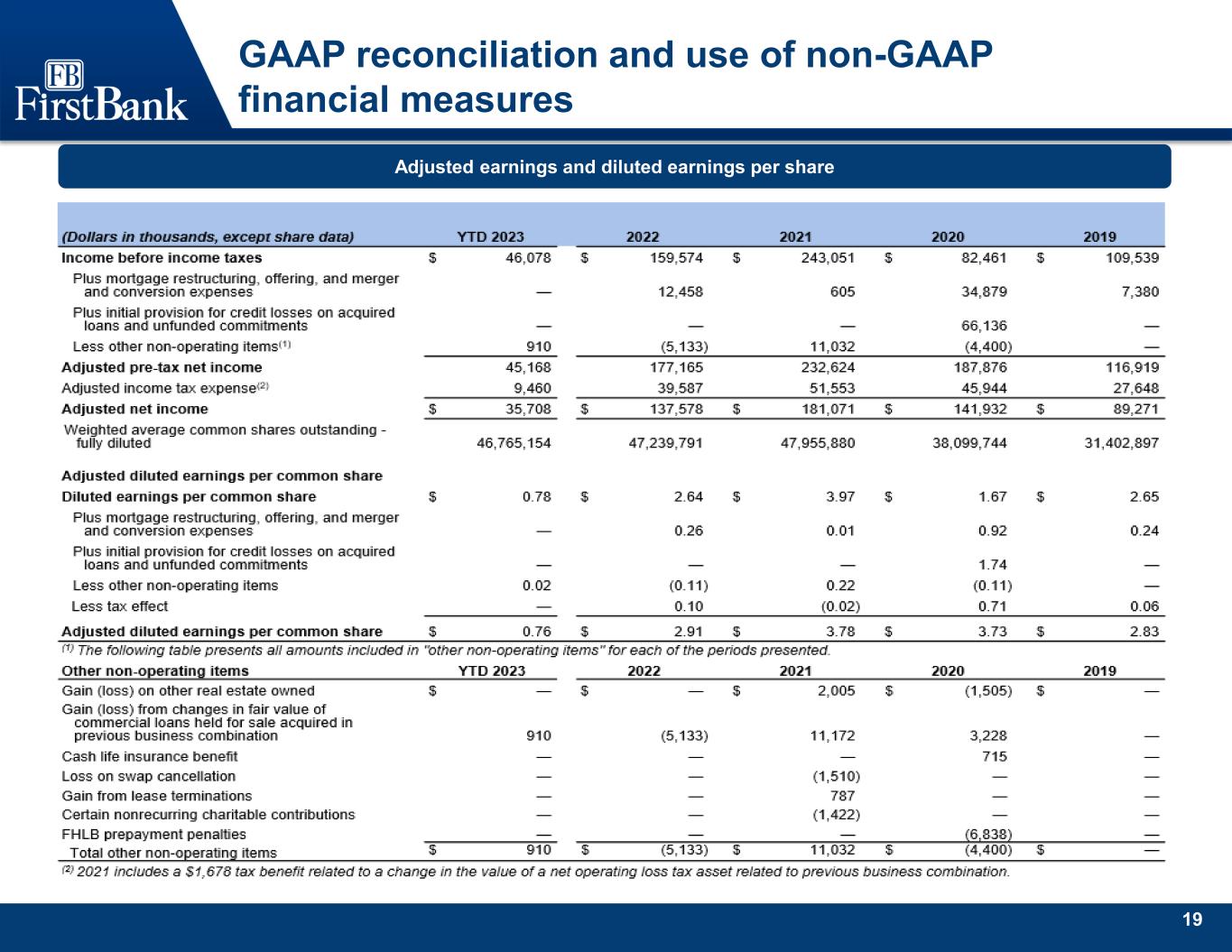
19 GAAP reconciliation and use of non-GAAP financial measures Adjusted earnings and diluted earnings per share

20 GAAP reconciliation and use of non-GAAP financial measures Adjusted pre-tax, pre-provision earnings

21 GAAP reconciliation and use of non-GAAP financial measures Core efficiency ratio (tax-equivalent basis)

22 GAAP reconciliation and use of non-GAAP financial measures Segment core efficiency ratios (tax-equivalent basis)
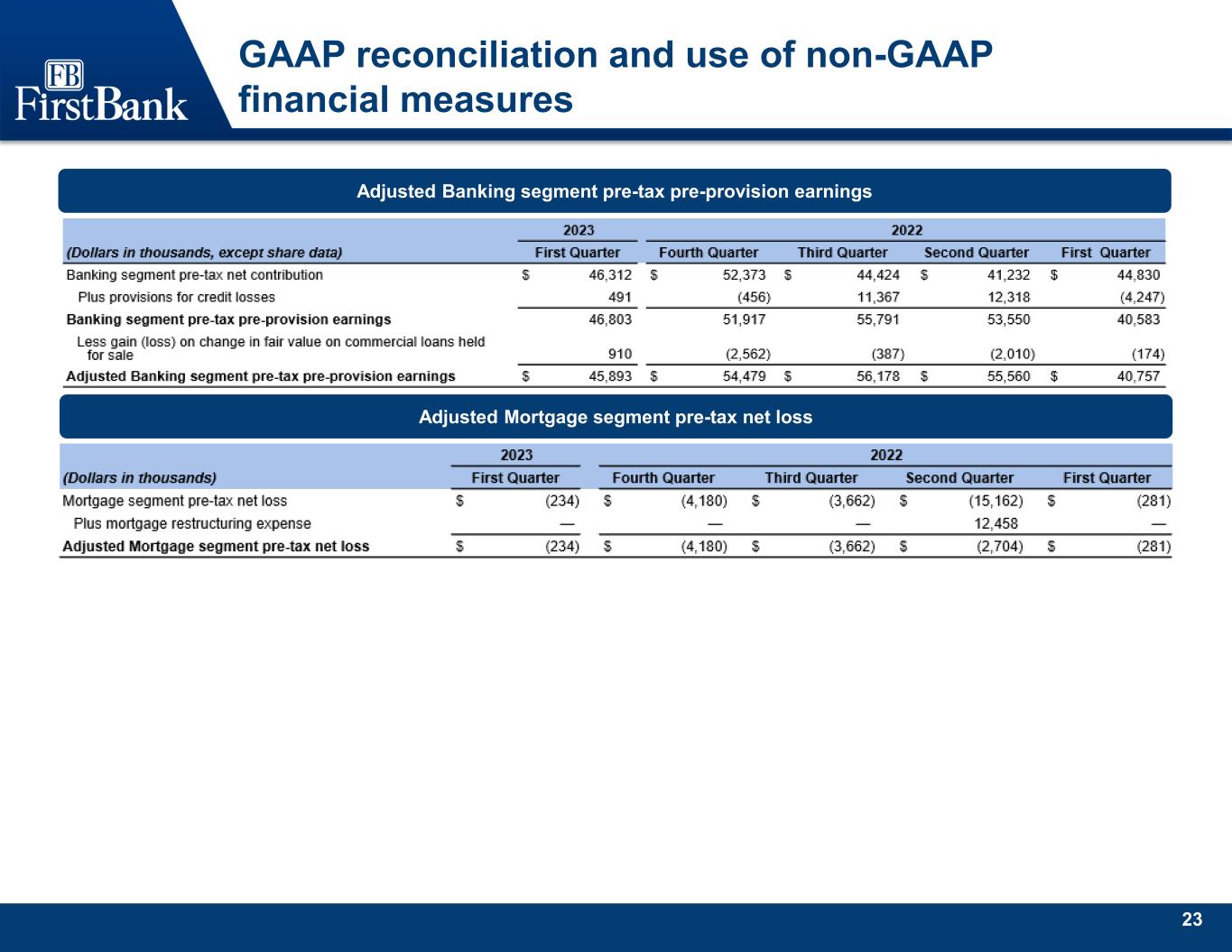
23 GAAP reconciliation and use of non-GAAP financial measures Adjusted Banking segment pre-tax pre-provision earnings Adjusted Mortgage segment pre-tax net loss

24 GAAP reconciliation and use of non-GAAP financial measures Tangible assets and equity, tangible book value per common share, tangible common equity to tangible assets, and on- balance sheet liquidity to tangible assets

25 GAAP reconciliation and use of non-GAAP financial measures Tangible assets and equity, tangible book value per common share and tangible common equity to tangible assets

26 GAAP reconciliation and use of non-GAAP financial measures Return on average tangible common equity
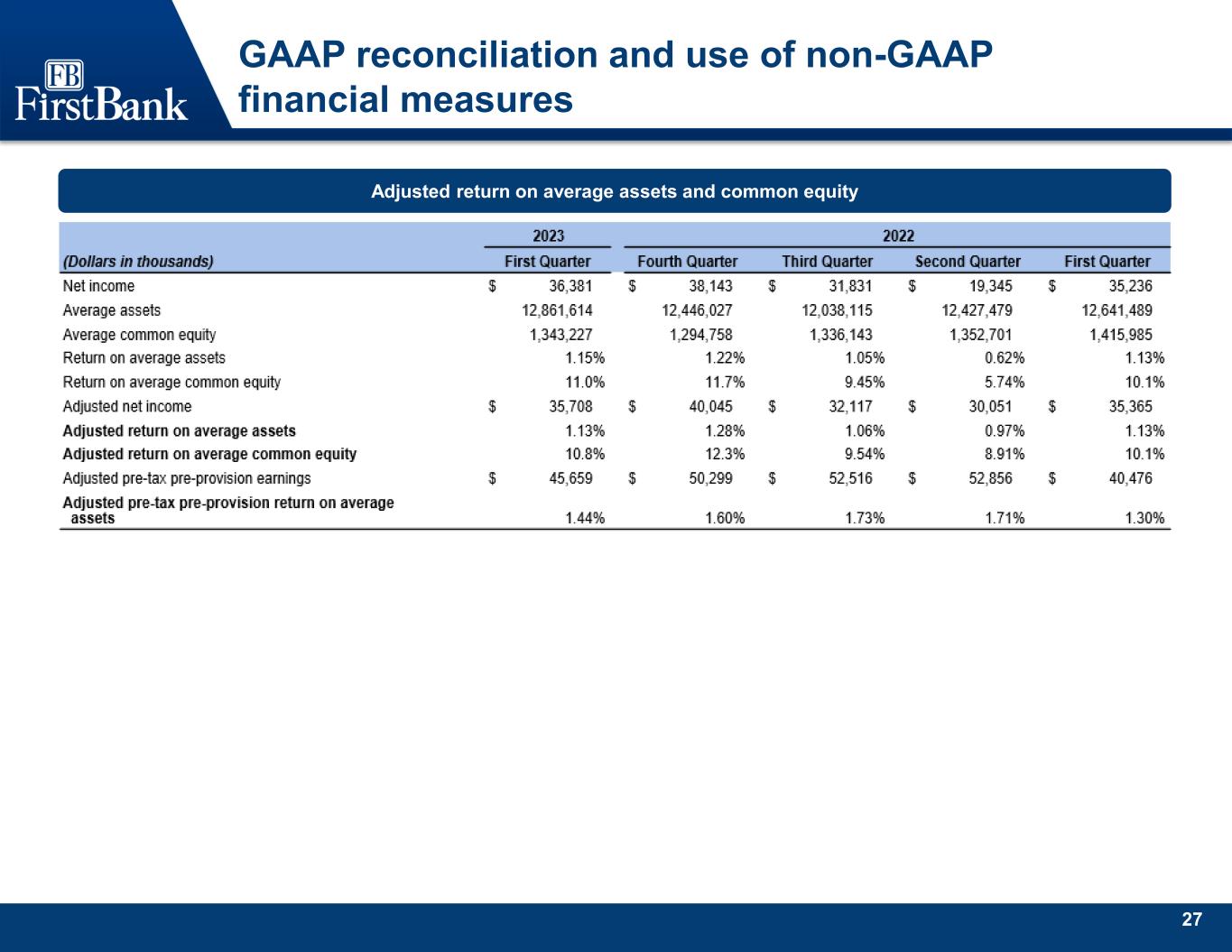
27 GAAP reconciliation and use of non-GAAP financial measures Adjusted return on average assets and common equity

28 GAAP reconciliation and use of non-GAAP financial measures Return on average tangible common equity
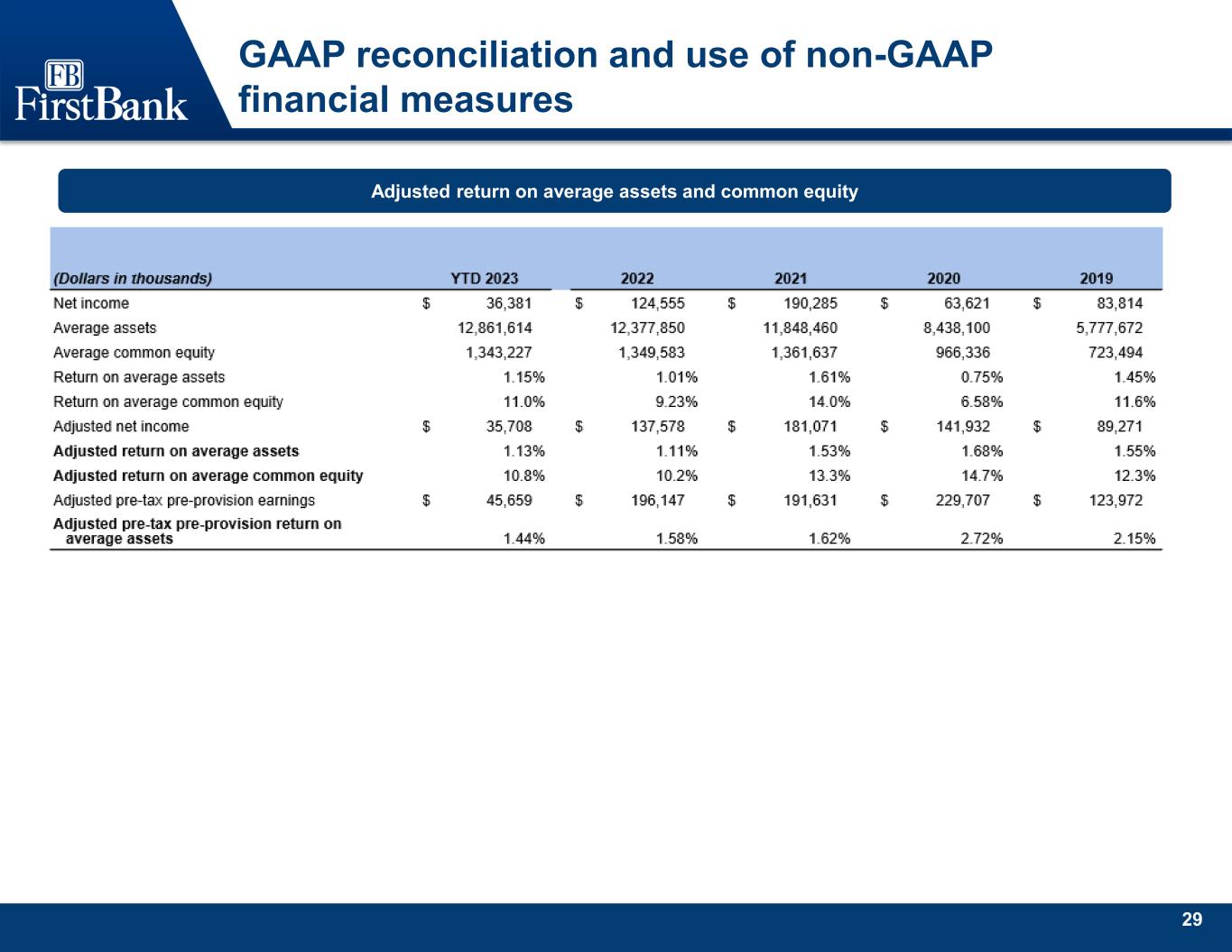
29 GAAP reconciliation and use of non-GAAP financial measures Adjusted return on average assets and common equity





























